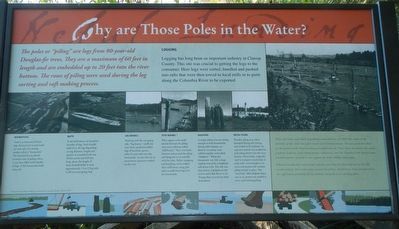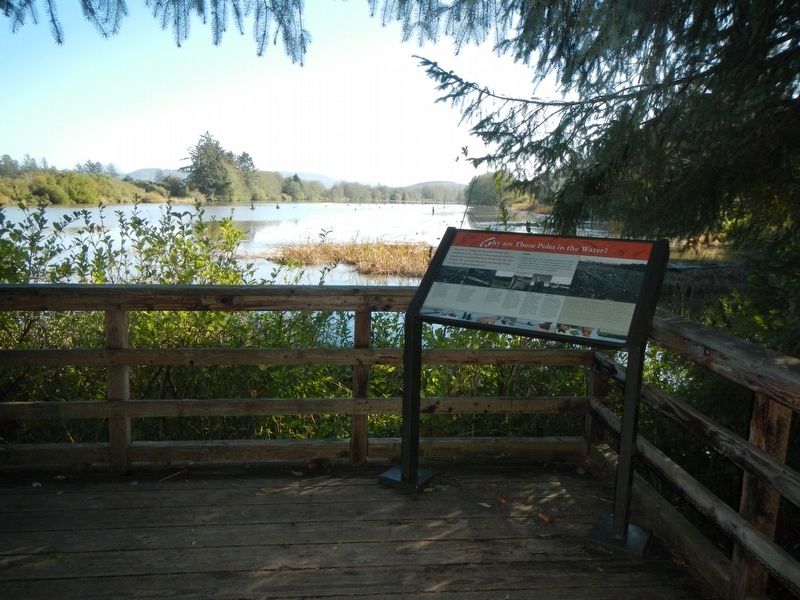Near Astoria in Clatsop County, Oregon — The American West (Northwest)
Why are Those Poles in the Water?
Inscription.
The poles or "piling" are logs from 80-year old Douglas-fir trees. They are a maximum of 60 feet in length and are embedded up to 20 feet into the river bottom. The rows of piling were used during the log sorting and raft making process.
Logging
Logging has long been an important industry in Clatsop County. This site was crucial to getting the logs to a consumer. Here logs were sorted, bundled and pushed into rafts that were towed to local mills or to ports along the Columbia River to be exported.
Boomsticks
Twelve to fourteen 64-foot logs chained end to end made up each side of a sorting pocket called a "boomstick." The broomstick was placed between rows of piling where it was then filled with bundles of logs. A full broomstick made a log raft.
Rafts
A raft held about one hundred bundles of logs. Each bundle held 24 to 36 logs depending on log diameter, length and species. A completed raft was 50 feet across and 820 feet long, about the length of three football fields! It took approximately 12 to 13 log rafts to fill an ocean-going ship.
Log Broncs
Working with the out-going tide, "log broncs." small one-man boats, pushed bundled logs of hemlock, spruce, alder, fir and cedar into boomsticks. At one time six or seven bronc operators worked on the river.
Stiff Booms
What appear to be small islands between the piling were once walkways called "stiff booms." They were built between and around the piling and designed to rise and fall with the tides. Before strapping and bundling, crews walked these stiff booms using pike poles to push loose logs onto the boomstick.
Dolphins
A single piling was not strong enough to hold boomsticks during tidal changes, so three to six piling were cabled together and called "dolphins." When a boomstick was full, a large tugboat towed the completed raft down river. The raft was then tied to a dolphin on the Lewis and Clark River or in Youngs Bay to await its final destination.
Metal Pilings
Wooden piling were often damaged during raft towing and needed to be replaced. An expensive permit was needed for each piling driven into the river bottom. Metal tubes, originally used to transport wood chips at pulp mills, were brought in to cover and preserve the wooden piling already in place. This "recycling" effort helped reduce cost as no permit was needed to cover a pre-existing piling.
When the Lewis and Clark Expedition wintered here, in 1805-06, much of the shoreline of this river was open marsh an forested swamp. The sort yard described on this panel made Netual Landing an industrial site. Since then, businesses; the wood products industry, local school groups, volunteers, and the National Park Service have worked together to make it into a place for both wildlife and people.
Pileated woodpeckers and purple martins now hunt for food and rest on the old wooden piling. River otters play around the piling. Small bones have been found on the stiff booms: probably left by animals using them as a feeding place.
Erected by National Park Service.
Topics. This historical marker is listed in these topic lists: Industry & Commerce • Man-Made Features • Natural Resources.
Location. 46° 7.951′ N, 123° 52.692′ W. Marker is near Astoria, Oregon, in Clatsop County. Marker can be reached from Fort Clatsop Road near Warrenton-Astoria Highway (Business U.S. 101), on the right when traveling south. Touch for map. Marker is at or near this postal address: 92345 Fort Clatsop Road, Astoria OR 97103, United States of America. Touch for directions.
Other nearby markers. At least 8 other markers are within 5 miles of this marker, measured as the crow flies. Traveling the Rivers (a few steps from this marker); Winter at Fort Clatsop (about 600 feet away, measured in a direct line); Sacagawea (about 800 feet away); Astoria & Warrenton (approx. 0.2 miles away); Fort Clatsop (approx. ¾ mile away); Japanese Bombardment (approx. 3.4 miles away); Astoria Sesquicentennial (approx. 3.7 miles away); Uniontown Curfew Bell (approx. 4.1 miles away). Touch for a list and map of all markers in Astoria.
More about this marker. This marker is located in Lewis and Clark National Historic Park.
Credits. This page was last revised on March 9, 2018. It was originally submitted on February 7, 2018, by Barry Swackhamer of Brentwood, California. This page has been viewed 3,991 times since then and 556 times this year. Last updated on March 7, 2018, by T. Patton of Jefferson, Georgia. Photos: 1, 2. submitted on February 7, 2018, by Barry Swackhamer of Brentwood, California. • Andrew Ruppenstein was the editor who published this page.

